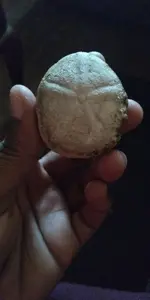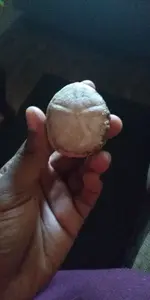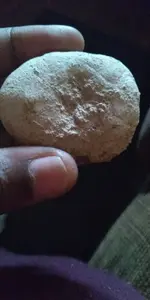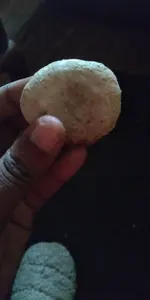You are using an out of date browser. It may not display this or other websites correctly.
You should upgrade or use an alternative browser.
You should upgrade or use an alternative browser.
Small Carved Rock
- Thread starter Kingbri24
- Start date
- Joined
- Dec 23, 2019
- Messages
- 6,336
- Reaction score
- 20,220
- Golden Thread
- 0
- Location
- Surrey, UK
- Primary Interest:
- All Treasure Hunting
Strictly speaking it's not a 'sand dollar'. We usually reserve that name for species of echinoid (sea urchin) fossils & non-fossils which have an extremely flattened shell, approaching a thinnish disk. It is nevertheless a sea urchin fossil of another species but unfortunately not valuable.
Last edited:
Upvote
0
Kray Gelder
Gold Member
- Joined
- Feb 24, 2017
- Messages
- 7,005
- Reaction score
- 12,558
- Golden Thread
- 0
- Location
- Georgetown, SC
- Detector(s) used
- Fisher F75
- Primary Interest:
- Metal Detecting
I would suggest it is a fossilized echinoderm ( a sea urchin from long ago that has lost it's spines).
Edit: Red Coat is a step ahead.
Edit: Red Coat is a step ahead.
Upvote
0
Strictly speaking it's not a 'sand dollar'. We usually reserve that name for species of echinoid (sea urchin) fossils which have an extremely flattened shell, approaching a thinnish disk. It is nevertheless a sea urchin fossil of another species but unfortunately not valuable.
It looks like it may be a fossilized heart urchin or maybe a cast of one judging by the lumpy rounded shape and lack of hole in the bottom.
Upvote
0
creskol
Gold Member
From Wikipedia, the free encyclopedia
Jump to navigationJump to search
[TABLE="class: infobox biota, width: 200"]
[TR]
[TH="bgcolor: #EBEBD2, colspan: 2, align: center"]Sand dollars
Temporal range: 56–0 Ma
O
S
D
C
P
T
J
K
Pg
N
Late Paleocene to Recent[SUP][1][/SUP]
[/TH]
[/TR]
[TR]
[TD="colspan: 2, align: center"]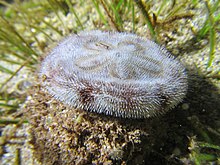 [/TD]
[/TD]
[/TR]
[TR]
[TD="colspan: 2, align: center"]A live individual of Clypeaster reticulatus(Mayotte)[/TD]
[/TR]
[TR]
[TH="bgcolor: #EBEBD2, colspan: 2, align: center"]Scientific classification[/TH]
[/TR]
[TR]
[TD]Kingdom:[/TD]
[TD]Animalia
[/TD]
[/TR]
[TR]
[TD]Phylum:[/TD]
[TD]Echinodermata
[/TD]
[/TR]
[TR]
[TD]Class:[/TD]
[TD]Echinoidea
[/TD]
[/TR]
[TR]
[TD]Subclass:[/TD]
[TD]Euechinoidea
[/TD]
[/TR]
[TR]
[TD]Superorder:[/TD]
[TD]Gnathostomata
[/TD]
[/TR]
[TR]
[TD]Order:[/TD]
[TD]Clypeasteroida
[/TD]
[/TR]
[TR]
[TH="bgcolor: #EBEBD2, colspan: 2, align: center"]Suborders and families[/TH]
[/TR]
[TR]
[TD="colspan: 2"]See text.
[/TD]
[/TR]
[/TABLE]
The term sand dollar (also known as a sea cookie or snapper biscuit in New Zealand, or pansy shell in South Africa) refers to species of extremely flattened, burrowing sea urchins belonging to the order Clypeasteroida. Some species within the order, not quite as flat, are known as sea biscuits. (Related animals include other sea urchins, sea cucumbers, and starfish.) Sand dollars can also be called "sand cakes" or "cake urchins".[SUP][2][/SUP]
Jump to navigationJump to search
[TABLE="class: infobox biota, width: 200"]
[TR]
[TH="bgcolor: #EBEBD2, colspan: 2, align: center"]Sand dollars
Temporal range: 56–0 Ma
PreЄ
ЄO
S
D
C
P
T
J
K
Pg
N
Late Paleocene to Recent[SUP][1][/SUP]
[/TH]
[/TR]
[TR]
[TD="colspan: 2, align: center"]
 [/TD]
[/TD][/TR]
[TR]
[TD="colspan: 2, align: center"]A live individual of Clypeaster reticulatus(Mayotte)[/TD]
[/TR]
[TR]
[TH="bgcolor: #EBEBD2, colspan: 2, align: center"]Scientific classification[/TH]
[/TR]
[TR]
[TD]Kingdom:[/TD]
[TD]Animalia
[/TD]
[/TR]
[TR]
[TD]Phylum:[/TD]
[TD]Echinodermata
[/TD]
[/TR]
[TR]
[TD]Class:[/TD]
[TD]Echinoidea
[/TD]
[/TR]
[TR]
[TD]Subclass:[/TD]
[TD]Euechinoidea
[/TD]
[/TR]
[TR]
[TD]Superorder:[/TD]
[TD]Gnathostomata
[/TD]
[/TR]
[TR]
[TD]Order:[/TD]
[TD]Clypeasteroida
[/TD]
[/TR]
[TR]
[TH="bgcolor: #EBEBD2, colspan: 2, align: center"]Suborders and families[/TH]
[/TR]
[TR]
[TD="colspan: 2"]See text.
[/TD]
[/TR]
[/TABLE]
The term sand dollar (also known as a sea cookie or snapper biscuit in New Zealand, or pansy shell in South Africa) refers to species of extremely flattened, burrowing sea urchins belonging to the order Clypeasteroida. Some species within the order, not quite as flat, are known as sea biscuits. (Related animals include other sea urchins, sea cucumbers, and starfish.) Sand dollars can also be called "sand cakes" or "cake urchins".[SUP][2][/SUP]
Upvote
0
Similar threads
- Replies
- 1
- Views
- 244
- Question
- Replies
- 9
- Views
- 277
- Question
🔎 UNIDENTIFIED
Could This Be An Eskimo Carving & What Stone Is it?
- Replies
- 5
- Views
- 499
Users who are viewing this thread
Total: 1 (members: 0, guests: 1)




